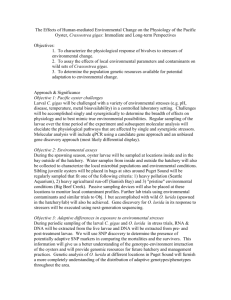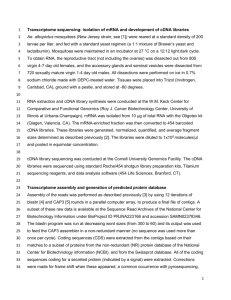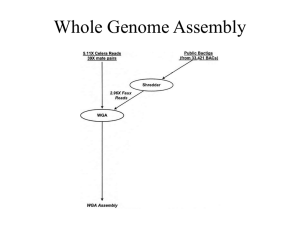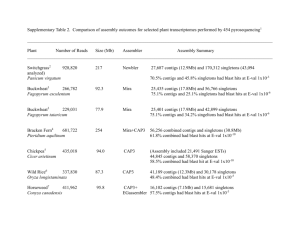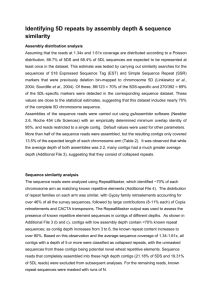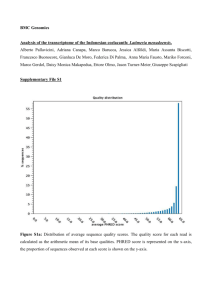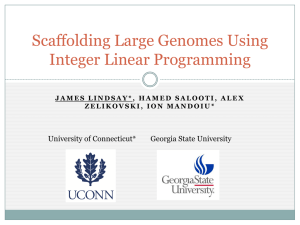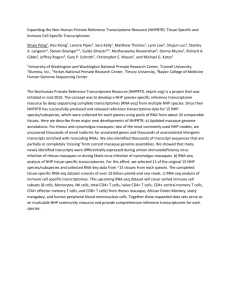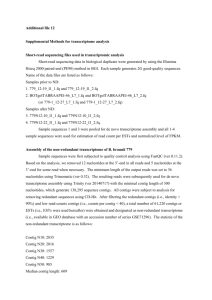- Figshare
advertisement
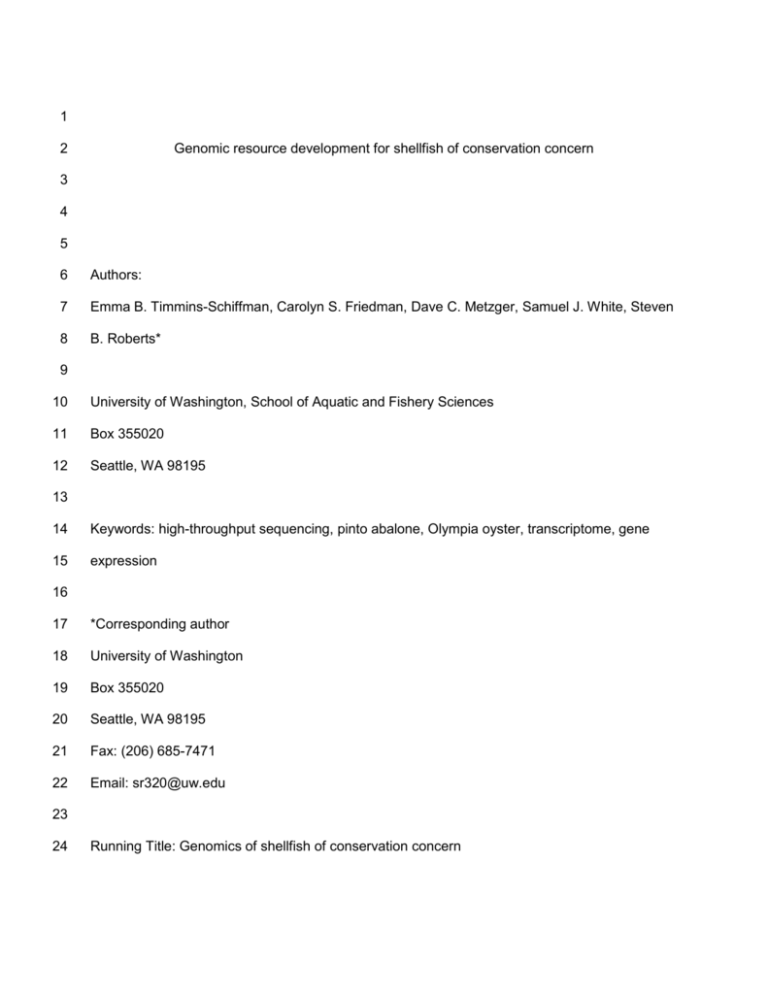
1 2 Genomic resource development for shellfish of conservation concern 3 4 5 6 Authors: 7 Emma B. Timmins-Schiffman, Carolyn S. Friedman, Dave C. Metzger, Samuel J. White, Steven 8 B. Roberts* 9 10 University of Washington, School of Aquatic and Fishery Sciences 11 Box 355020 12 Seattle, WA 98195 13 14 Keywords: high-throughput sequencing, pinto abalone, Olympia oyster, transcriptome, gene 15 expression 16 17 *Corresponding author 18 University of Washington 19 Box 355020 20 Seattle, WA 98195 21 Fax: (206) 685-7471 22 Email: sr320@uw.edu 23 24 Running Title: Genomics of shellfish of conservation concern 25 Abstract 26 Effective conservation of threatened species depends on the ability to assess organism 27 physiology and population demography. In order to develop genomic resources to better 28 understand the dynamics of two ecologically vulnerable species in the Pacific Northwest of the 29 United States, larval transcriptomes were sequenced for the pinto abalone Haliotis 30 kamtschatkana kamtschatkana and the Olympia oyster Ostrea lurida. Based on comparative 31 species analysis the Ostrea lurida transcriptome (41,136 contigs) is relatively complete. These 32 transcriptomes represent the first significant contribution to genomic resources for both species. 33 Genes are described based on biological function with a particular attention to those associated 34 with temperature change, oxidative stress, and immune function. In addition, transcriptome 35 derived genetic markers are provided. Together, these resources provide valuable tools for 36 future studies aimed at conservation of Haliotis kamtschatkana, Ostrea lurida and related 37 species. 38 39 40 Introduction Effective conservation efforts are dependent on understanding how organisms respond 41 to environmental conditions (Wikelski & Cooke 2006). One means to assess physiological 42 responses is to evaluate changes at the molecular level. Often, valuable insight can be gained 43 from assessing gene expression variation that would not be readily evident from ecological 44 observations. For instance, in Crassostrea virginica larvae, specific gene expression patterns as 45 determined through qPCR were found to signal an early mortality event (Genard et al. 2012). 46 Quantitative PCR has also been used to characterize the effects of ocean acidification on the 47 purple sea urchin Strongylocentrotus purpuratus (Stumpp et al. 2011), Mediterranean sea 48 urchin Paracentrotus lividus (Martin et al. 2011), red abalone Haliotis rufescens (Zippay and 49 Hofmann 2010), and red sea urchin Strongylocentrotus franciscanus (O’Donnell et al. 2009). 50 These studies revealed that ocean acidification alters metabolism and calcification (Stumpp et 51 al. 2011; Martin et al. 2011) and limits an effective heat shock response (O’Donnell et al. 2009). 52 Transcriptomic data can be used to increase our understanding not only of an 53 organismal response, but can also aid in characterizing population structure and dynamics. 54 Understanding population genetic structure can further the knowledge needed to increase the 55 success of conservation efforts (e.g. restoration, relocation). This includes providing necessary 56 information to maintain effective genetic diversity (Reed & Frankham 2003) and, in some cases, 57 ensuring native cohorts are not diminished (Frankham 2002). High-throughput sequencing of 58 transcriptomes can reveal a breadth of markers (e.g. single nucleotide polymorphisms or SNPs) 59 that are informative not only for population demographics, but also for understanding ecological 60 and evolutionary mechanisms. For example high-throughput sequencing of transcriptomes has 61 been used to identify SNPs in the non-model Glanville fritillary butterfly (Melitaea cinxia; Vera et 62 al. 2008), species in the fish genus Xiphophorus (Shen et al. 2012), and oilseed rape (Brassica 63 napus; Trick et al. 2009). The SNPs discovered in B. napus were successfully tested for use in 64 linkage mapping (Trick et al. 2009). While not necessarily required a priori, sufficient genomic 65 resources can greatly increase a researcher’s ability to plan, implement, and monitor success of 66 conservation efforts. 67 The overall objective of the current effort was to develop genomic resources for two 68 shellfish species of conservation concern in the coastal region of northwest North America: the 69 pinto abalone, Haliotis kamtschatkana kamtschatkana (hereafter referred to as H. 70 kamtschatkana), and Olympia oysters, Ostrea lurida. The pinto (or northern) abalone is an IUCN 71 listed species of concern (NOAA 2007) distributed from Alaska through Point Conception, 72 California. Harvest of pinto abalone has been outlawed along its range since the 1990s, except 73 in Alaska where recreational and subsistence harvest are still permitted. Within the past two 74 decades, significant declines have been reported in pinto abalone populations in the San Juan 75 Archipelago (Washington, USA), with evidence of decreased recruitment and potential for 76 inhibited capacity to reproduce based on low population density (Rothaus et al. 2008, Bouma et 77 al. 2012). Greater than expected mortality of mature H. kamtschatkana has been observed in 78 the southeast Queen Charlotte Islands, BC, suggesting that poaching is still a valid concern for 79 this threatened species (Hankewich et al. 2008). In the southern end of their range, H. 80 kamtschatkana are threatened by warming ocean temperatures, poaching, and predation by 81 sea otters (Rogers-Bennett 2007). Marine reserves have been shown to promote both 82 population growth and reproductive output in pinto abalone (Wallace 1999). 83 Olympia oysters are the only native oyster species on the United States west coast and 84 are another species of conservation concern with a coastwide distribution. In the state of 85 Washington O. lurida are listed as a candidate Species of Concern. Overexploitation of O. 86 lurida in the late 1800s through the early 1900s led to significant reductions of natural 87 populations (White et al. 2009). Water pollution and decreased availability of suitable habitat 88 compounded the effects of overharvest and led to further declines in O. lurida populations along 89 the coast (White et al. 2009; Groth & Rumrill 2009; Gillespie 2009). Olympia oyster populations 90 are still found along the majority of their historical distribution, indicating a possibility for 91 rebuilding the species, however, densities are much lower than they once were (Polson & 92 Zacherl 2009). O. lurida restoration efforts have been increasing in recent years (McGraw 93 2009) and include efforts such as habitat remediation and hatchery supplementation of natural 94 populations (e.g. Dinnel et al. 2009). 95 96 This study describes the larval transcriptomes of the pinto (northern) abalone, Haliotis kamtschatkana, and the Olympia oyster, Ostrea lurida, with the objective of developing genomic 97 resources for further conservation and management purposes. Along with descriptions of the 98 full transcriptomes and identification of genes associated with environmental stress response, 99 we also identify putative genetic markers for both species. 100 101 Materials & Methods 102 103 104 Sampling and Library Construction Olympia oyster larvae were spawned at the Taylor Shellfish Hatchery in Quilcene, WA. 105 Larvae were transferred to the University of Washington six hours post spawning. Larvae (12 106 larvae/ml) were evenly distributed to six 4.5-L larval chambers. Larvae were sampled from all 107 chambers by filtering them onto a 35 µm screen and flash freezing in liquid N2 on days one, two, 108 and three post-fertilization. Two RNA-seq libraries were constructed from mRNA and 109 sequenced at the University of Washington High Throughput Genomics Unit (HTGU) on the 110 Illumina Hi-Seq 2000 platform (Illumina, San Diego, CA, USA). Both libraries were made of 111 pooled mRNA from 3 chambers across all sampling time points. Each library was run on a 112 single lane. 113 Pinto abalone larvae were spawned at the Mukilteo Research Station in Mukilteo, WA 114 and transported to the University of Washington at 3 days post-fertilization. Larvae (two 115 larvae/ml) were held in eight 4.0-L chambers and on day 4 post-fertilization, all larvae were 116 sampled for sequencing by filtering them onto a 70 µm screen and flash freezing them in liquid 117 N2. Similar to the Olympia oyster samples, two RNA-Seq libraries were constructed from pooled 118 mRNA samples (from four chambers each). Pinto abalone libraries were run together on one 119 lane of the Illumina Hi-Seq 2000 (Illumina) at the University of Washington HTGU. 120 121 Sequence Analysis 122 Sequence analysis was performed with CLC Genomics Workbench version 5.0 (CLC 123 bio, Katrinebjerg, Denmark). Quality trimming was performed using the following parameters: 124 quality score 0.05 (Phred; Ewing & Green, 1998; Ewing et al., 1998), number of ambiguous 125 nucleotides <2 on ends, and reads shorter than 25 bp were removed. De novo assembly was 126 performed on the quality trimmed reads using the following parameters: mismatch cost = 2, 127 deletion cost = 3, similarity fraction = 0.9, insertion cost = 3, length fraction = 0.8 and minimum 128 contig size of 200 bp. Sequences were annotated by comparing contiguous sequences to the 129 UniProtKB/Swiss-Prot database (http://uniprot.org) using the BLASTx algorithm (Altschul et al. 130 1997) with a 1.0E-5 e-value threshold. Genes were classified according to their biological 131 processes as determined by their Gene Ontology (GO) and classified into their parent 132 categories (GO Slim). 133 To assess the completeness of the transcriptomes, contigs from both species were 134 assessed to determine if they contained orthologs to proteins found in all Metazoa. Specifically, 135 OrthoDB (Waterhouse et al. 2011, http://cegg.unige.ch/orthodb6) was used obtain a suite of 136 proteins from Lottia gigantea (the giant owl limpet) found as single copy, which have orthologs 137 in all other metazoans in OrthoDB. Sequence comparisons (tBLASTn; Altschul et al. 1997) 138 were performed to find matching contigs in H. kamtschatkana and O. lurida transcriptomes. An 139 e-value threshold of 1E-10 was used. In order to determine what proportion of full-length coding 140 regions were obtained, sequences were translated and aligned to corresponding L. gigantea 141 proteins (Geneious Pro version 5.3.6; Kearse et al. 2012). Alignment parameters are as follows: 142 BLOSUM 62 cost matrix, gap open penalty of 12, gap extension penalty of 3, global alignment 143 with free end gaps, and 2 refinement iterations. Percent coverage of the L. gigantea protein by 144 the O. lurida or H. kamtschatkana contig was then calculated. 145 Using a more global approach to assess the larval transcriptomes of O. lurida and H. 146 kamtschatkana, all contigs were compared using the BLASTn algorithm (Altschul et al. 1997) to 147 publicly available transcriptomes of other shellfish, as well as to zebrafish. Specific datasets 148 used include transcriptomes of Pacific oyster, Crassostrea gigas (GigasDatabase version 8; 149 Fleury et al., 2009); pearl oyster, Pinctada fucata (Predicted Transcripts from Genome 150 Assembly ver 1.0; http://marinegenomics.oist.jp/genomes/download?project_id=0; Takeuchi et 151 al. 2012); South African abalone, Haliotis midae transcriptome (Franchini et al. 2011); Manila 152 clam, Ruditapes philippinarum (RuphiBase (http://compgen.bio.unipd.it/ruphibase/); and 153 zebrafish, Danio rerio (NCBI RefSeq mRNA, ftp://ftp.ncbi.nih.gov/refseq/D_rerio/). 154 In order to investigate the functions of contigs that did not have significant matches in 155 the transcriptomes of the species listed above, gene enrichment analysis was performed. Gene 156 ontology information associated with enriched unique gene set was identified using the 157 Database for Annotation, Visualization, and Integrated Discovery (DAVID) v. 6.7 (Huang et al. 158 2009a and 2009b, http://david.abcc.ncifcrf.gov/). The background gene list was made from the 159 UniProtKB/Swiss-Prot database accession numbers that corresponded to the entire 160 transcriptome of either H. kamtschatkana or O. lurida. 161 Phylogenetic analysis of select stress response genes was conducted with sequences 162 from the following species: O. lurida, H. kamtschatkana, H. midae, P. fucata, C. gigas, R. 163 philippinarum, and D. rerio. Target genes and corresponding sequence accession numbers for 164 each species are provided in Table 1. Sequences were aligned in Geneious Pro version 5.3.6 165 (Kearse et al. 2012) and trimmed to the length of the shortest sequence. Parameters for 166 alignment included cost matrix 65% similarity (5.0/-4.0), gap open penalty of 12, and gap 167 extension penalty of 3. Phylogenetic trees were made using Geneious tree builder with the 168 genetic distance model HKY, neighbor-joining tree build method, Danio rerio as the outgroup, 169 100x bootstrap, and 50% support threshold. 170 171 172 Single Nucleotide Polymorphism (SNP) Identification Single Nucleotide Polymorphism (SNP) detection was carried out on O. lurida and H. 173 kamtschatkana assemblies using the following parameters: window length = 11, maximum gap 174 and mismatch count = 2, minimum central base quality = 20, minimum coverage = 10, 175 maximum coverage =1000, and minimum variant frequency = 35% (Genomics Workbench v. 5; 176 CLC bio). 177 178 Results 179 Larval Transcriptomes 180 Two larval transcriptome libraries were constructed and sequenced for Olympia oyster 181 (O. lurida) and pinto abalone (H. kamtschatkana). Given that quality and yield from 182 complementary libraries were consistent, all sequencing reads were combined within each 183 species. Following quality trimming, 387,720,843 sequencing reads remained from the 184 combined Olympia oyster (O. lurida) larval libraries. For pinto abalone (H. kamtschatkana), 185 94,777,799 quality reads remained. Raw sequence data is available in the NCBI Short Read 186 Archive (Accession Number SRA057107). 187 De novo assembly of sequencing reads from each species generated 41,136 and 8,641 188 contigs for O. lurida and H. kamtschatkana, respectively (Supp_1_Ostrea_lurida transcriptome 189 and Supp_2_Haliotis_kamtschatkana_transcriptome). The average contig lengths were 611 bp 190 for O. lurida and 401 bp for H. kamtschatkana (Table 2). 191 192 193 Transcriptome Annotation A total of 15,381 (37%) O. lurida contigs were annotated based on the UniProt- 194 SwissProt database (Supp_3_Ostrea_lurida_SPIDs) with associated gene ontology information 195 available for 8,030 contigs (Supp_4_Ostrea_lurida_GO and Figure 1). A total of 1,277 (15%) 196 H. kamtschatkana contigs were annotated based on the UniProt-SwissProt database 197 (Supp_5_Haliotis_kamtschatkana_SPIDs) with associated gene ontology information available 198 for 574 contigs (Supp_6_Haliotis_kamtschatkana_GO and Figure 2). 199 Of the 30 orthologus proteins found across Metazoa, and found as a single copy in L. 200 gigantea, 28 O. lurida contigs were identified with sequence similarity matches. A majority of the 201 O. lurida contigs (24) had e-values <1E-50. The average coverage of O. lurida contigs based on 202 the corresponding L. gigantea protein was 53.7%. In contrast, only 2 proteins found across 203 Metazoa were identified in the H. kamtschatkana transcriptome. 204 205 206 Comparative Transcriptome Analysis Of the 41,136 contigs from the O. lurida larval library, transcriptomes from the C. gigas 207 and P. fucata oysters had the highest similarity to O. lurida, 21,748 and 11,101 matching 208 contigs, respectively (Figure 3). The D. rerio transcriptome had the next highest number of 209 matches with 6,015, followed in order by H. midae, R. philippinarum, and H. kamtschatkana 210 (Figure 3). A summary of matches to O. lurida contigs in each dataset is provided with 211 respective bit scores provided for each pairwise blast comparison 212 (Supp_7_Ostrea_lurida_bitscores). 213 Of the 8,641 contigs from the H. kamtschatkana library, the H. midae database had the 214 most matches with 3,090 BLAST hits (Figure 4). Comparison with the other transcriptomic 215 datasets all produced fewer than 1,000 matches (Figure 4). A summary of matches to H. 216 kamtschatkana contigs in each dataset is provided with respective bit scores for each pairwise 217 blast comparison (Supp_8_Haliotis_kamtschatkana_bitscores). 218 There were 1,315 genes without matches to other transcriptomes in the O. lurida 219 transcriptome (3.2% of the all the contigs) and 243 with no matches to other transcriptome in 220 the H. kamtschatkana transcriptome (2.8% of all contigs). The O. lurida unique contigs were 221 enriched in the GO Slim categories of developmental processes, cell organization and 222 biogenesis, cell adhesion, transport, stress response, signal transduction, and protein 223 metabolism (Table 3). The H. kamtschatkana unique contigs were enriched in the GO Slim 224 terms of stress response and RNA metabolism (Table 3). 225 Analysis using select stress response genes resulted in phylogenetic tree clustering that 226 was consistent with taxonomic relationships. Specifically, H. kamtschatkana and H. midae 227 clustered together with high confidence (100%) except for the gene hsp82 where H. midae and 228 R. philippinarum clustered together with a bootstrap confidence of 50% but within the same 229 phyletic group as H. kamtschatkana (bootstrap confidence of 93%) (Figure 5). O. lurida 230 consistently clustered with C. gigas with high bootstrap support (v-type proton ATPase 85%, 231 transmembrane protein 85 99%, hsp82 66%, heat shock 70 cognate 67%, GABA 99%) (data 232 not shown). However, O. lurida hsp70 clustered more closely with the corresponding gene in P. 233 fucata (bootstrap confidence 68%). 234 235 236 SNP Characterization In the O. lurida transcriptome, 59,221 putative SNPs were identified within 19,354 237 contigs (Supp_9_Ostrea_lurida_SNPs). A subset of these putative SNPs (27,818) were within 238 annotated genes, corresponding to 6,328 protein descriptions. In the H. kamtschatkana 239 transcriptome, 6,596 putative SNPs were identified within 3,378 contigs 240 (Supp_10_Haliotis_kamtschatkana_SNPs). A subset of these putative SNPs (1,038) were 241 within annotated genes, corresponding to 442 protein descriptions. The functional distribution of 242 SNPs among contigs (as determined by GO and GO Slim terms) was not significantly different 243 from the annotation of the entire transcriptome for both O. lurida and H. kamtschatkana. 244 245 246 Discussion This research effort has dramatically increased the amount of genomic data available in 247 O. lurida and H. kamtschatkana. At the time the project was undertaken there were on a few 248 hundred publicly available sequences for the species combined. Here we provide 8,641 H. 249 kamtschatkana and 41,136 O. lurida contig sequences representing the larval transcriptomes. 250 The O. lurida contigs represent a more complete transcriptome as compared to the H. 251 kamtschatkana dataset. This is not unexpected as approximately 3 times more reads were 252 sequenced for O. lurida compared to H. kamtschatkana. Evidence to support the relative 253 completeness of the O. lurida transcriptome includes the fact that the number of contigs from de 254 novo assembly is similar to what has been reported in other species. Specific examples include 255 Ciona intestinalis species B (27,426 contigs; Cahais et al. 2012), Lepus granatensis (38,540 256 contigs; Cahais et al. 2012), and Radix balthica (>20,000; Feldmeyer et al. 2011). Furthermore, 257 using OrthoDB, we found evidence that over 90% of the proteins found across Metazoa were 258 present in the O. lurida transcriptome. Together these data suggest that 14 gigabases of ultra 259 short read (~36bp) high throughput transcriptome sequencing can produce a robust 260 transcriptome. It would be expected that more sequences and longer read length would 261 increase the number of full length sequences and facilitate identification of transcripts expressed 262 at a minimal level. While not complete in nature, both transcriptomes characterized here 263 provide a wealth of information, evidenced in part by the number of sequences that did not have 264 a significant match in cross-species comparisons. 265 In addition to characterizing the transcripts based on sequence homology, a suite of 266 transcriptome derived SNPs are reported. Recently there have been several examples where 267 transcriptome derived SNPs have provided unique insight into population dynamics. For 268 example, high-throughput sequencing of the Pacific herring, Clupea pallasii, transcriptome 269 yielded SNPs that were used to discriminate population structure between ocean basins 270 (Roberts et al. 2012). Interestingly, one locus (Cpa_APOB) was a virus response gene and 271 differentiation across populations at this locus suggested a disease pressure could contribute to 272 the delayed recovery of Pacific herring (Roberts et al 2012). In Pacific oysters, Crassostrea 273 gigas, transcriptome derived SNPs have been used to create a linkage map and find 274 quantitative trait loci linked to summer mortality and viral infection (Sauvage et al. 2010). 275 Another example includes the application of SNPs derived from the Glanville fritillary butterfly, 276 Melitaea cinxia, transcriptome (Vera et al. 2008) that were used in a separate large-scale study 277 to characterize metapopulation structure (Wheat et al. 2011). It should be pointed out that while 278 there are advantages to using transcriptome derived SNPs, there are also drawbacks. 279 Foremost, these markers are characterized at the genomic DNA level and the absence of 280 introns in the transcriptome can contribute to marker “drop-out” during validation (Seeb et al 281 2011). While it is beyond the scope of this effort to validate and use these markers to 282 characterize population structure, the annotated SNPs provided for H. kamtschatkana and O. 283 lurida will be a valuable resource future efforts to examine restoration and conservation activity. 284 Through phylogenetic analysis and comparative species analysis, both O. lurida and H. 285 kamtschatkana contigs have the overall greatest transcriptome similarity with closely related 286 species, C. gigas and H. midae, respectively. There was not a consistent direct relationship 287 between phylogenetic relatedness and the number of shared sequences. This is likely related to 288 the incomplete nature of some of the transcriptome datasets used for comparison. For example, 289 in both species the fully sequenced transcriptome of Danio rerio had a greater number of 290 sequence matches than some invertebrates. Gene specific phylogenetic analysis generally 291 demonstrated clustering along taxonomic lines, though there were some exceptions. Similarly, 292 this is likely due to the incomplete nature of transcripts from some species, which limited the 293 robustness of the comparison. 294 Even though most genes were shared across multiple, related species, both O. lurida 295 and H. kamtschatkana had significant subsets of expressed genes that did not have matches in 296 other species based on sequence similarity. For both species, these contigs were enriched for 297 genes involved in the environmental stress response. The sequence dissimilarity across taxa is 298 likely associated with the species and environmental specific interactions. In other words it 299 would be expected that the constitutively expressed, housekeeping genes would be conserved, 300 while genes involved in transient processes (e.g. immune function) could diverge based on 301 environmental pressure (e.g. disease, temperature). Another explanation for the relatively large 302 number of unique sequences is that a majority of the other datasets were not specifically larval 303 transcriptomes, but were derived from adult tissue. This is supported by the fact that the 304 enriched biological processes wtih the largest number of genes in O. lurida was developmental 305 processes. It is also possible that both species may possess some genes that have no 306 homologs across taxa, or potential “orphan” genes (Tautz & Domazet-Loso 2011). As additional 307 sequence information is available for related species it is likely there will be greater attention 308 directed toward these whole genome level evolutionary questions. 309 310 One important aspect of conservation is understanding how an organism responds to environmental change. As part of this sequencing effort we identified a suite of genes that are 311 involved in the stress response that could be used in future studies to assess the physiological 312 state and fitness of an organism. One group of genes that fits this description is molecular 313 chaperones. O. lurida and H. kamtschatkana larvae express genes homologous to high 314 molecular weight molecular chaperones, including heat shock protein 70 (hsp70) 315 (Ostrea_lur_contig14040, Haliotis_kam_contig8247), hsp83 (Ostrea_lur_contig402, 316 Haliotis_kam_contig7441), and hsp90 (Ostrea_lur_contig7674, Haliotis_kam_contig1648). 317 Chaperones in the HSP70 family are responsible for the proper folding of nascent polypeptides 318 as well as providing a response to environmental stress (reviewed in Hendrick & Hartl 1993; 319 Kawabe & Yokoyama 2011; Chapman et al. 2011; Genard et al. 2012). Different isoforms of 320 HSP70 are expressed either constitutively, in response to stress, or in the endoplasmic 321 reticulum or mitochondria (reviewed in Parcellier et al. 2003). Heat shock protein 70 and its 322 transcription factor, heat shock transcription factor 1, are important in the physiological response 323 of Crassostrea gigas to both emersion and hypoxia (Kawabe & Yokoyama 2011). Increased 324 expression of hsp70 transcript can also act as a biomarker, signaling the onset of a mortality 325 event in C. virginica larvae up to a week before it occurs (Genard et al. 2012) as well as 326 indicating adult C. virginica exposure to high temperature or low pH in natural populations 327 (Chapman et al. 2011). Expression of HSP70 also increases in the gills of zebra mussel, 328 Dreissena polymorpha, by 24 hours post-exposure to copper and mercury (Navarro et al. 2011). 329 The HSP90 family, including HSP90 and HSP83, bind to various receptors and can be 330 associated with signaling proteins (Hendrick & Hartl 1993; Parcellier et al. 2003). The 331 expression of HSP90 can also be stress-induced and can stimulate and inhibit ubiquitylation 332 (Parcellier et al. 2003). The mRNA of hsp90 is up-regulated in response to changes in dietary 333 selenium in the Pacific abalone, Haliotis discus hannai Ino (Zhang W et al. 2011), dietary zinc in 334 H. discus hanai (Wu et al. 2011), and salinity and bacteria challenges in Crassostrea 335 hongkongensis (Fu et al. 2011). Global climate change is expected to significantly change the 336 temperature regimes and other environmental factors in the coastal ocean (IPCC 2007). Using 337 general stress biomarkers such as heat shock proteins could be useful in monitoring resilience 338 and adaptive potential in native invertebrate populations. 339 A second set of genes identified in O. lurida and H. kamtschatkana larval transcriptomes 340 included genes associated with oxidative stress and antioxidant activity. Invertebrate exposure 341 to pathogens and other common environmental stresses frequently results in increased 342 expression of genes and proteins associated with oxidative stress. Oxidative stress is caused 343 by proliferation of reactive oxygen species (ROS), which can promote apoptosis in cells (Wang 344 et al. 1998). ROS oxidize proteins, which can accelerate cellular aging and lead to disease 345 (Berlett & Stadtman 1997). The degradation of these damaged oxidized proteins is affected by 346 the concentration of antioxidants (Berlett & Stadtman 1997), such as the enzymes identified in 347 O. lurida and H. kamtschatkana. A number of proteins scavenge reactive oxygen species to 348 minimize cellular damage, which makes them reliable biomarkers of a variety of stresses. 349 Antioxidant genes identified in O. lurida and H. kamtschatkana included peroxiredoxin-6 350 (Ostrea_lur_contig1185, Haliotis_kam_contig6404), superoxide dismutase 351 (Ostrea_lur_contig1691, Haliotis_kam_contig8349), catalase (Ostrea_lur_contig24174), 352 cytochrome P450 (Ostrea_lur_contig24499, Haliotis_kam_contig5816), and glutathione-s- 353 transferase (Ostrea_lur_contig27247, Haliotis_kam_contig5954). Peroxiredoxin-6 (prx6) is 354 expressed at a higher level in C. virginica larvae one week before they experience a mortality 355 event, when compared to those that do not undergo mortality (Genard et al. 2012). The 356 transcript of prx6 is also expressed at higher levels in natural populations of C. gigas in the 357 winter in contaminated estuaries (David et al. 2007). Superoxide dismutase (sod) and catalase 358 (cat) increase in expression in H. discus hannai exposed to elevated dietary zinc (Wu et al. 359 2011). Catalase is an important component of C. hongkongensis’s immune response during a 360 bacterial challenge and has been shown to protect cells from H2O2-induced apoptosis (Zhang Y 361 et al. 2011). Both CAT and SOD activities were up-regulated in channel catfish, Ictalurus 362 punctatus, after exposure to contaminated sediment (Di Guilio et al. 1993). Cytochrome P450 is 363 up-regulated in the mussel Mytilus galloprovincialis upon exposure to and bioaccumulation of 364 the contaminant PCB (Livingstone et al. 1997). Glutathione-s-transferase (gst) has been found 365 to be a good predictor of C. virginica exposure to copper and iron (Chapman et al. 2011). GST 366 activity is also up-regulated in channel catfish that were exposed to contaminated sediment that 367 promoted tumor growth in aquatic organisms (Di Giulio et al. 1993). All of these antioxidant 368 enzymes are reliable indicators of physiological stress caused by a harmful environment and 369 can be applied as biomarkers to monitor populations of O. lurida and H. kamtschatkana. 370 Genes that code for proteins that accomplish a wide variety of roles in the innate 371 immune response were also identified. These include cathepsins (Ostrea_lur_contig19125, 372 Haliotis_kam_contig4888), tumor necrosis factor (TNF) receptor (Ostrea_lur_contig22192), Toll- 373 like receptor (Ostrea_lur_contig811), and mitogen activated protein kinase (MAPK) 374 (Ostrea_lur_contig10231). Some of these genes, like TNF receptor and MAPK, act upstream of 375 pathways that affect the oxidative stress response (Wang et al., 1998). MAPKs are conserved 376 across eukaryotes and are instrumental in activating a variety of enzymes in response to 377 environmental change (reviewed in Johnson & Lapadat 2002). A subfamily of MAPKs, p38 378 enzymes, have proven to be an important component of invertebrate response to a variety of 379 environmental stressors, such as oxidative stress, hypoxia, osmostic stress, and immune 380 challenge (Travers et al. 2009; Gaitanaki et al. 2004; Canesi et al. 2002). TNF receptor is 381 associated with several immune response pathways. TNFα induces phagocytic activity and 382 affects phosphorylation of the MAPK pathway in Mytilus galloprovincialis hemocytes (Betti et al. 383 2006). A TNFα homolog was cloned and sequenced in the disk abalone, Haliotis discus discus, 384 and its transcript increased expression in the abalone gill tissue upon exposure to both bacteria 385 and a virus (DeZoysa et al. 2009). Similarly, Toll-like receptors also play an integral role in 386 signaling pathways during an immune response (reviewed in Barton & Medzhitov 2003). 387 Homologs of toll-like receptors have been implicated in bacterial immune response in the 388 Zhikong scallop, Chlamys farreri (Qiu et al. 2007), and in C. gigas (Zhang L et al. 2011). 389 Cathepsins represent a wide class of enzymes, the roles of which include immune function, 390 repair, and apoptosis (reviewed in Conus & Simon 2010). Gene expression of cathepsins has 391 been shown to be an indicator of environmental stress in invertebrates. A cathepsin-B 392 precursor transcript was expressed more highly in grass shrimp, Palaemonetes pugio, exposed 393 to the pesticides fibpronil and endosulfan when compared to controls (Griffitt et al. 2006). The 394 expression of cathepsin-L mRNA also increased upon C. gigas exposure to thermal stress 395 (Meisterzheim et al. 2007). While disease mortality is has not considered a major culprit in the 396 decreased population levels of O. lurida or H. kamtschatkana, these gene sequences will be 397 important resource to examine immune function and resilience. Additionally these gene 398 sequences could be used in isolating and characterizing homologs in closely related species. 399 For example, the pathogen Candidatus Xenohaliotis californiensis has been identified as a 400 major contributor to the decline of other Haliotis species such as the black abalone, H. 401 cracherodii (Friedman & Finley 2003). Gene sequences from H. kamtschatkana could easily be 402 used to study differential disease resistance in population, which could directly aid in restoration 403 activity. 404 In summary, we have characterized genomic resources for two species of conservation 405 concern that, prior to this effort, had limited molecular information available. These data will 406 provide essential information that could be used for future physiological (i.e. gene expression) 407 and genetic based research carried out for planning, implementation, and monitoring of 408 conservation efforts. 409 410 References 411 Altschul SF, Madden TL, Schäffer AA, Zhang J, Zhang Z, Miller W, Lipman DJ (1997) Gapped 412 BLAST and PSI-BLAST: a new generation of protein database search programs. Nucl. Acids 413 Res., 25, 3389-3402. 414 415 Barton GM, Medzhitov R (2003) Toll-Like Receptor Signaling Pathways. Science, 300, 1524- 416 1525. 417 418 Berlett BS, Stadtman ER (1997) Protein Oxidation in Aging, Disease, and Oxidative Stress. 419 JBC, 272, 20313-20316. 420 421 Betti M, Ciacci C, Lorusso LC, Cononico B, Falcioni T, Gallo G, Canesi L (2006) Effects of 422 tumor necrosis factor α (TNFα) on Mytilus haemocytes: role of stress-activated mitogen- 423 activated protein kinases (MAPKs). Biology of the Cell, 98, 233-244. 424 425 Bouma JV, Rothaus DP, Straus KM, Vadopalas B, Friedman CS (2012) Low Juvenile Pinto 426 Abalone Haliotis kamtschatkana kamtschatkana Abundance in the San Juan Archipelago, 427 Washington State. Transactions of the American Fisheries Society, 141, 76-83. 428 429 Cahais V, Gayral P, Tsagkogeorga G, Melo-Ferreira J, Ballenghien M, Weinert L, Chiari Y, 430 Belkhir K, Ranwez V, Galtier N (2012) Reference-free transcriptome assembly in non-model 431 animals from next-generation sequencing data. 432 433 Canesi L, Betti M, Ciacci C, Scarpato A, Cietterio B, Pruzzo C, Gallo G (2002) Signaling 434 pathways involved in the physiological response of mussel hemocytes to bacterial challenge: 435 the role of stress-activated p38 MAP kinases. Developmental & Comparative Immunology, 26, 436 325-334. 437 438 Chapman RW, Mancia A, Beal M, Veloso A, Rathburn C, Blair A, Holland AF, Warr GW, 439 Didinato G, Sokolova IM, Writh EF, Duffy E, Sanger D (2011) The transcriptomic responses of 440 the eastern oyster, Crassostrea virginica, to environmental conditions. Molecular Ecology, 20, 441 1431-1449. 442 443 Conus S, Simon H-U (2010) Cathepsins and their involvement in immune responses. Swiss 444 Med Wkly, 140, w13042. 445 446 David E, Tanguy A, Moraga D (2007) Peroxiredoxin 6: A new physiological and genetic indicator 447 of multiple environmental stress response in Pacific oyster Crassostrea gigas. Aquatic 448 Toxicology, 84, 389-398. 449 450 DeZoysa M, Jung S, Lee J (2009) First molluscan TNF- α homologue of the TNF superfamily in 451 disk abalone: Molecular characterization and expression analysis. Fish & Shellfish Immunology, 452 26, 625-631. 453 454 Di Guilio RT, Habig C, Gallagher EP (1993) Effects of Black Rock Harbor sediments on indices 455 of biotransformation, oxidative stress, and DNA integrity in channel catfish. Aquatic Toxicology, 456 26, 1-22. 457 458 Dinnel, PA, Peabody B, Peter-Contesse T (2009) Rebuilding Olympia oysters, Ostrea lurida 459 Carpenter 1864, in Fidalgo Bay, Washington.Journal of Shellfish Research, 28, 79-85. 460 461 Ewing B, Green P (1998) Base-Calling of Automated Sequencer Traces Using Phred. II. Error 462 Probabilities. Genome Res., 8, 186-194. 463 464 Ewing B, Hillier L, Wendl MC, Green P (1998) Base-Calling of Automated Sequencer Traces 465 Using Phred. I. Accuracy Assessment. Genome Res., 8, 175-185. 466 467 Feldmeyer B, Wheat CW, Krezdorn N, Rotter B, Pfenninger M (2011) Short read Illumina data 468 for the de novo assembly of a non-model snail species transcriptome (Radix balthica, 469 Basommatophora, Pulmonata), and a comparison of assembler performance. BMC Genomics, 470 12, doi: 10.1186/1471-2164-12-317. 471 472 Fleury E, Huvet A, Lelong C, Lorgeril J, Voulo V, Gueguen Y, Bachère E, Tanguy A, Moraga D, 473 Fabioux C, Lindeque P, Shaw J, Reinhardt R, prunet P, Davey G, Lapègue S, Sauvage C, 474 Corporeau C, Moal J, Gavory F, Wincker P, Moreews F, Klopp C, Mathieu M, Boudry P, Favrel 475 P (2009) Generation and analysis of 29,745 unique Expressed Sequence Tags from the Pacific 476 oyster (Crassostrea gigas) assembled into a publicly accessible database, the GigasDatabase. 477 BMC Genomics, 10, doi:10.1186/1471-2164-10-341. 478 479 Franchini P, van der Merwe M, Roodt-Wilding R (2011) Transcriptome characterization of the 480 South African abalone Haliotis midae using sequencing-by-synthesis. BMC Research Notes, 4, 481 doi:10.1186/1756-0500-4-59. 482 483 Frankham R (2002) Relationship of Genetic Variation to Population Size in Wildlife. 484 Conservation Biology, 10, 1500-1508. 485 486 Friedman CS, Finley CA (2003) Anthropogenic introduction of the etiological agent of withering 487 syndrome into northern California abalone populations via conservation efforts. Canadian 488 Journal of Fisheries and Aquatic Sciences, 60, 1424-1431. 489 490 Fu D, Chen J, Zhang Y, Yu Z (2011) Cloning and expression of a heat shock protein (HSP) 90 491 gene in the haemocytes of Crassostrea hongkongensis under osmotic stress and bacterial 492 challenge. Fish & Shellfish Immunology, 31, 118-125. 493 494 Gaitanaki C, Kefaloyianni E, Marmari A, Beis I (2004) Various stressors rapidly activate the p38- 495 MAPK signaling pathway in Mytilus galloprovincialis (Lam.). Molecular and Cellular 496 Biochemistry, 260, 119-127. 497 498 Genard B, Moraga D, Pernet F, David E, Boudry P, Tremblay R (2012) Expression of candidate 499 genes related to metabolism, immunity and cellular stress during massive mortality in the 500 American oyster Crassostrea virginica larvae in relation to biochemical and physiological 501 parameters. Gene, 499, 70-75. 502 503 Gillespie GE (2009) Status of the Olympia Oyster, Ostrea lurida Carpenter 1864, in British 504 Columbia, Canada. Journal of Shellfish Research, 28, 59-68. 505 506 Griffitt RJ, Chandler GT, Greig TW, Quattro JM (2006) Cathepsin B and Glutathione Peroxidase 507 Show Differing Transcriptional Responses in the Grass Shrimp, Palaemonetes pugio Following 508 Exposure to Three Xenobiotics. Environ. Sci. & Technol., 40, 3640-3645. 509 510 Groth S, Rumrill S (2009) History of Olympia Oysters (Ostrea lurida Carpenter 1864) in Oregon 511 Estuaries, and a Description of Recovering Populations in Coos Bay. Journal of Shellfish 512 Research, 28, 51-58. 513 514 Hankewich S, Lessard J, Grebeldinger E (2008) Resurvey of Northern Abalone, Haliotis 515 kamtschatkana, Populations in Southeast Queen Charlotte Islands, British Columbia, May 2007. 516 Can. Manuscr. Rep. Fish. Aquat. Sci., 2839, vii + 39 pp. 517 518 Hendrick JP, Hartl F (1993) Molecular Chaperone Functions of Heat-shock Proteins. Annu. Rev. 519 Biochem., 62, 349-384. 520 521 Huang DW, Sherman BT, Lempicki RA (2009a) Systematic and integrative analysis of large 522 gene lists using DAVID Bioinformatics Resources. Nature Protoc., 4, 44-57. 523 524 Huang DW, Sherman BT, Lempicki RA (2009b) Bioinformatics enrichment tools: paths toward 525 the comprehensive functional analysis of large gene lists. Nucleic Acids Res., 37, 1-13. 526 527 Johnson GL, Lapadat R (2002) Mitogen-Activated Protein Kinase Pathways Mediated by ERK, 528 JNK, and p38 Protein Kinases. Science, 298, 1911-1912. 529 530 IPCC (Intergovernmental Panel on Climate Change) (2007) Contribution of Working Groups I, II, 531 and III to the Fourth Assessment Report of the Intergovernmental Panel on Climate Change. 532 Core Writing Team, Pachauri RK, Reisinger A (Eds) IPCC, Geneva, Switzerland, pp104. 533 534 Kawabe S, Yokoyama Y (2011) Novel isoforms of heat shock transcription factor 1 are induced 535 by hypoxia in the Pacific oyster Crassostrea gigas. Journal of Experimental Zoology Part A: 536 Ecological Genetics and Physiology, 315A, 394-407. 537 538 Kearse M, Moir R, Wilson A, Stones-Havas S, Cheung M, Sturrock S, Buxton S, Cooper A, 539 Markowtiz S, Duran C, Thierer T, Ashton B, Meintjes P, Drummond A (2012) Geneious Basic: 540 An integrated and extendable desktop software platform for the organization and analysis of 541 sequence data. Bioinformatics, 28, 1647-1649. 542 543 Livingstone DR, Nasci C, Solé M, Da Ros L, O’Hara SCM, Peters LD, Fossato V, Wootton AN, 544 Godfarb PS (1997) Apparent induction of a cytochrom P450 with immunochemical similarities to 545 CYP1A in digestive gland of the common mussel (Mytilus galloprovincialis L.) with exposure to 546 2,2’,3,4,4’,5’-hexachlorobiphenyl and Arochlor 1254. Aquatic Toxicology, 38, 205-224. 547 548 Martin S, Richier S, Pedrotti M, Dupont S, Castejon C, Gerakis Y, Kerros M, Oberha¨nsli F, 549 Teyssié J, Jeffree R, Gattuso J (2011) Early development and molecular plasticity in the 550 Mediterranean sea urchin Paracentrotus lividus exposed to CO2-driven acidification. J Exp. 551 Biol., 214, 1357-1368. 552 553 McGraw K (2009) The Olympia Oyster, Ostrea lurida Carpenter 1864 Along the West Coast of 554 North America. Journal of Shellfish Research, 28, 5-10. 555 556 Navarro A, Faria M, Barata C, Piña B (2011) Transcriptional response of stress genes to metal 557 exposure in zebra mussel larvae and adults. Environmental Pollution, 159, 100-107. 558 559 NOAA (National Oceanographic and Atmospheric Administration) (2007) Species of Concern 560 NOAA National Marine Fisheries Service, Pinto abalone Haliotis kamtschatkana. NOAA, Silver 561 Spring, MD. 562 563 O’Donnell MJ, Hammond LM, Hofmann GE (2009) Predicted impact of ocean acidification on a 564 marine invertebrate: elevated CO2 alters response to thermal stress in sea urchin larvae. Mar. 565 Biol., 156, 439-446. 566 567 Parcellier A, Burbuxani S, Schmitt E, Solary E, Garrido C (2003) Heat shock proteins, cellular 568 chaperones that modulate mitochondrial cell death pathways. Biochemical and Biophysical 569 Research Communications, 304, 505-512. 570 571 Polson MP, Zacherl DC (2009) Geographic Distribution and Intertidal Population Status for the 572 Olympia Oyster, Ostrea lurida Carpenter 1864, from Alaska to Baja. Journal of Shellfish 573 Research, 28, 68-77. 574 575 Qiu L, Song L, Xu W, Ni D, Yu Y (2007) Molecular cloning and expression of a Toll receptor 576 gene homologue from Zhikong Scallpo, Chlamys farreri. Fish & Shellfish Immunology, 22, 451- 577 466. 578 579 Reed DH, Frankham R (2003) Correlation between Fitness and Genetic Diversity. Conservation 580 Biology, 17, 230-237. 581 582 Roberts SB, Hauser L, Seeb LW, Seeb JE (2012) Development of Genomic Resources for 583 Pacific Herring through Targeted Transcriptome Pyrosequencing. PLoS One, 7, e30908. 584 doi:10.1371/journal.pone.0030908. 585 586 Rogers-Bennett L (2007) Is climate change contributing to range reductions and localized 587 extinctions in northern (Haliotis kamtschatkana) and flat (Haliotis walallensis) abalones? Bulletin 588 of Marine Science, 81, 283-296. 589 590 Rothaus DP, Vadopalas B, Friedman CS (2008) Precipitous declines in pinto abalone (Haliotis 591 kamtschatkana kamtschatkana) abundance in the San Juan Archipelago, Washington, USA, 592 despite statewide fishery closure. Canadian Journal of Fisheries and Aquatic Sciences, 65, 593 2703-2711. 594 595 Sauvage C, Boudry P, De Koning D-J, Haley CS, Heurtebise S, Lapègue S (2010) QTL for 596 resistance to summer mortality and OsHV-1 load in the Pacific oyster (Crassostrea gigas). 597 Animal Genetics, 41, 390-399. 598 599 Seeb JE, Pascal CE, Grau ED, Seeb LW, Templin WD, Harkins T, Roberts SB (2011) 600 Transcriptome sequencing and high-resolution melt analysis advance single nucleotide 601 polymorphism discovery in duplicated salmonids. Molecular Ecology Resources, 11, 335-348. 602 603 Shen Y, Catchen J, Garcia T, Amores A, Beldorth I, Wagner J, Zhang Z, Postlethwait J, Warren 604 W, Schartl M, Walter RB (2012) Identification of transcriptome SNPs between Xiphophorus lines 605 and species for assessing allele specific gene expression within F1 interspecies hybrids. 606 Comparative Biochemistry and Physiology Part C: Toxicology & Pharmacology, 1, 102-108. 607 608 Stumpp M, Dupont S, Thorndyke MC, Melzner F (2011) CO2 induced seawater acidification 609 impacts sea urchin larval development II: Gene expression patterns in pluteus larvae. 610 Comparative Biochemistry and Physiology Part A: Molecular & Integrative Physiology, 160, 320- 611 330. 612 613 Takeuchi T, Kawashima T, Koyanagi R, Fyoja F, Tanaka M, Ikuta T, Shoguchi E, Fujiwara M, 614 Shinzato C, Hisata K, Fujie M, Usami T, Nagai K, Maeyama K, Okamoto K, Aoki H, Ishikawa T, 615 Masaoka T, Fuijwara A, Endo K, Endo H, Hagasawa H, Kinoshita S, Asakawa S, Watabe S, 616 Satoh N (2012) Draft Genome of the Pearl Oyster Pinctada fucata: A Platform for 617 Understanding Bivalve Biology. DNA Research, 19, 117-130. 618 619 Tautz D, Domazet-Loso T (2011) The evolutionary origin of orphan genes. Nature Reviews, 12, 620 692-702. 621 622 Travers M, Le Bouffant R, Friedman CS, Buzin F, Cougard B, Huchette S, Koken M, Paillard C 623 (2009) Pathogenic Vibrio harveyi, in contrast to non-pathogenic strains, intervenes with the p38 624 MAPK pathway to avoid an abalone haemoctye immune response. Journal of Cellular 625 Biochemistry, 106, 152-160. 626 627 Trick M, Long Y, Meng J, Bancroft I (2009) Single nucleotide polymorphis (SNP) discovery in 628 the polyploid Brassica napus using Solexa transcriptome sequencing. Plant Biotechnology 629 Journal, 7, 334-346. 630 631 Vera JC, Wheat C, Fescemyer HW, Frilander MJ, Crawford CL, Hanski I, Marden JH (2008) 632 Rapid transcriptome characterization for a nonmodel organism using 454 pyrosequencing. 633 Molecular Ecology, 17, 1636-1647. 634 635 Wallace SS (1999) Evaluating the Effects of Three Forms of Marine Reserve on Northern 636 Abalone Populations in British Columbia, Canada. Conservation Biology, 13, 882-887. 637 638 Wang X, Martindale JL, Liu Y, Holbrook NJ (1998) The cellular response to oxidative stress: 639 influences of mitogen-activated protein kinase signaling pathways on cell survival. Biochem. J., 640 15, 291-300. 641 642 Wheat CW, Fescemyer HW, Kvist J, Tas E, Vera JC, Frilander MJ, Hanski I, Marden JH (2011) 643 Functional genomics of life history variation in a butterfly metapopulation. Molecular Ecology, 644 20, 1813-1828. 645 646 White J, Ruesink JL, Trimble AC (2009) The Nearly Forgotten Oyster: Ostrea lurida Carpenter 647 1864 (Olympia Oyster) History and Management in Washington State. Journal of Shellfish 648 Research, 28, 43-49. 649 650 Waterhouse RM, Adobnov EM, Tegenfeldt F, Li J, Kriventseva EV (2011) OrthoDB: the 651 hierarchical catalog of eukaryotic orthologs in 2011. Nucl. Acids Res., 39, 652 doi:10.1093/nar/gkq930. 653 654 Wikelski M, Cooke SJ (2006) Conservation physiology. Trends in Ecology & Evolution, 21, 28- 655 46. 656 657 Wu C, Zhang W, Mai K, Xu W, Zhong X (2011) Effects of dietary zinc on gene expression of 658 antioxidant enzymes and heat shock proteins in hepatopancreas of abalone Haliotis discus 659 hannai. Comparative Biochemistry and Physiology Part C: Toxicology & Pharmacology, 154, 1- 660 6. 661 662 Zhang L, Li L, Zhang G (2011) A Crassostrea gigas Toll-like receptor and comparative analysis 663 of TLR pathway in invertebrates. Fish & Shellfish Immunology, 30, 653-660. 664 665 Zhang W, Wu C, Mai K, Chen Q, Xu W (2011) Molecular cloning, characterization and 666 expression analysis of heat shock protein 90 from Pacific abalone, Haliotis discus hannai Ino in 667 response to dietary selenium. Fish & Shellfish Immunology, 30, 280-286. 668 669 Zhang Y, Fu D, Yu F, Liu Q, Yu Z (2011) Two catalase homologs are involved in host protection 670 against bacterial infection and oxidative stress in Crassostrea hongkongensis. Fish & Shellfish 671 Immunology, 31, 894-903. 672 673 Zippay ML, Hofmann GE (2010) Effect of pH on Gene Expression and Thermal Tolerance of 674 Early Life History Stages of Red Abalone (Haliotis rufescens). Journal of Shellfish Research, 29, 675 429-439. 676 677 Data Accessibility 678 mRNA Sequences: NCBI SRA SRA057107 679 Final RNA sequence assembly uploaded as online supplemental material 680 SNP data: uploaded as online supplemental material 681 682 Acknowledgements 683 The authors would like to thank Taylor Shellfish Farms for supplying the Olympia oyster larvae 684 and Puget Sound Restoration Fund for supplying the pinto abalone larvae. We would also like 685 to thank Liza Ray who helped to execute the pinto abalone part of this experiment. Lisa 686 Crosson, Samantha Brombacker, and Elene Dorfmeier helped with larval care and sampling. 687 We are grateful to Josh Bouma who provided comments during the writing process. This work 688 was funded in part by the Washington Sea Grant project grant number NA10OAR4170057 689 (awarded to Dr. Carolyn Friedman). This work was also partially funded from Washington Sea 690 Grant, University of Washington, pursuant to National Oceanographic and Atmospheric 691 Administration Award No. NA10OAR4170057 Project R/LME/N—3 (awarded to Dr. Steven 692 Roberts). The views expressed herein are those of the authors and do not necessarily reflect 693 the views of NOAA or any of its sub-agencies. 694 695 Figure Legends 696 Figure 1. Functional classification of O. lurida contigs based on GO Slim terms associated with 697 Biological Processes. Other biological processes and other metabolic processes are not 698 shown. 699 700 Figure 2. Functional classification of H. kamtschatkana contigs based on GO Slim terms 701 associated with Biological Processes. Other biological processes and other metabolic 702 processes are not shown. 703 704 Figure 3. Percent coverage of O. lurida transcriptome in comparison with the transcriptomes of 705 closely related species. The C. gigas database has the most coverage of the O. lurida 706 transcriptome (52.8%) and the H. kamtschatkana database covers the least (1.9%). There are 707 a total of 82,312 contigs in the C. gigas transcriptome database, 72,597 in the P. fucata 708 database, 28,304 in the D. rerio database, 22,761 in the H. midae database, 32,606 in the R. 709 philippinarum database, and 8,641 in the H. kamtschatkana database. 710 711 Figure 4. Percent coverage of H. kamtschatkana transcriptome in comparison with the 712 transcriptomes of closely related species. The H. midae database has the most coverage of the 713 O. lurida transcriptome (35.8%) and the R. philippinarum database covers the least (6.0%). 714 There are a total of 22,761 contigs in the H. midae transcriptome database, 82,312 contigs in 715 the C. gigas database, 41,136 contigs in the O. lurida database, 28,304 contigs in the D. rerio 716 database, 72,597 contigs in the P. fucata database, and 32,606 contigs in the R. philippinarum 717 database. 718 719 Figure 5. Phylogenetic trees of hsp82 (panel A), hsp70 (panel B), transmembrane protein 85 720 (panel C), and cathepsin-L (panel D). Each tree includes sequences for all species (O. lurida, 721 H. kamtschatkana, C. gigas, H. midae, P. fucata, R. philippinarum, and D. rerio) except when 722 the sequence for a particular species did not fit in the alignment. Bootstrap consensus support 723 is shown at the nodes. 724 725 Tables & Figures 726 Table 1. Contig identification and accession numbers for the sequences used to build 727 phylogenetic trees. Numbers are specific to the database from which the contigs were taken 728 (see Materials & Methods section). 729 730 731 Table 2. Sequencing statistic summaries for high-throughput sequencing of O. lurida and H. 732 kamtschatkana transcriptomes. 733 734 735 Table 3. Summary of unique genes and their functional categories for O. lurida and H. 736 kamtschatkana. For each species, the total number of contigs corresponding to unique genes 737 in enriched biological processes are given. Total number of contigs (for enriched and non- 738 enriched biological processes) are in bold. 739 740 741 742 743 744 745 O.#lurida H.#kamtschatkana Number$of$contigs$in$category Number'Unique'Genes 1315 243 RNA$metabolism . 5 Stress$response 65 3 Cell$adhesion 156 . Cell$organization$and$biogenesis 241 . Developmental$processes 328 . Protein$metabolism 268 . Signal$transduction 114 . Transport 39 . 746 747 748 749 750 751 752 753 754 755 756 Figure 1 757 Figure 2 DNA(metabolism( protein(metabolism( developmental(processes( death( cell(organiza0on( and(biogenesis( cell(cycle(and( prolifera0on( cell(adhesion( RNA(metabolism( signal(transduc0on( transport( stress(response( 758 759 760 761 762 763 764 765 766 767 768 769 770 771 772 Figure 3 773 774 775 776 Figure 4 777 Figure 5 778 779 780 781 Supplementary Data Legends 782 Supp_1_Ostrea_lurida_transcriptome. Assembled contigs of O. lurida transcriptome 783 sequencing. 784 785 Supp_2_Haliotis kamtschatkana_transcriptome. Assembled contigs of H. kamtschatkana 786 sequencing. 787 788 Supp_3_Ostrea_lurida_SPIDs. BLASTx results for O. lurida contig search against the 789 UniProtKB/Swiss-Prot database. BLAST e-values and gene descriptions are also given. 790 791 Supp_4_Ostrea_lurida_GO. Gene Ontology annotations of O. lurida contigs. GO annotations 792 are made based on associations with a Swiss-Prot ID. 793 794 Supp_5_Haliotis_kamtschatkana_SPIDs. BLASTx results for H. kamtschatkana contig search 795 against the UniProtKB/Swiss-Prot database. BLAST e-values and gene descriptions are also 796 given. 797 798 Supp_6_Haliotis_kamtschatkana_GO. Gene Ontology annotations of H. kamtschatkana contigs. 799 GO annotations are made based on associations with a Swiss-Prot ID. 800 801 Supp_7_Ostrea_lurida_bitscores. Bit scores for BLASTn results of O. lurida contigs against 802 species-specific databases of other closely related species. 803 804 Supp_8_Haliotis_kamtschatkana_bitscores. Bit scores for BLASTn results of H. kamtschatkana 805 contigs against species-specific databases of other closely related species. 806 807 Supp_9_Ostrea_lurida_SNPs. SNP information for putative SNPs identified in the O. lurida 808 transcriptome. Contig numbers are listed in the leftmost column, followed by SNP location and 809 allele. Annotations of the contigs, as determined through a BLASTx against the 810 UniProtKB/Swiss-Prot database, are given along with the e-value for the BLAST result. 811 812 Supp_10_Haliotis_kamtschatkana_SNPs. SNP information for putative SNPs identified in the H. 813 kamtschatkana transcriptome. Contig numbers are listed in the leftmost column, followed by 814 SNP location and allele. Annotations of the contigs, as determined through a BLASTx against 815 the UniProtKB/Swiss-Prot database, are given along with the e-value for the BLAST result. 816 817 Author Contributions Box 818 ETS performed the analyses and contributed to writing of the manuscript. CSF and SBR were 819 responsible for experimental design and provided funding for the research. SBR helped to 820 write the manuscript as well. DCM and SJW performed the lab work for the O. lurida and H. 821 kamtschatkana parts of the experiment, respectively. All co-authors contributed comments and 822 editing during the manuscript writing process. 823 824
